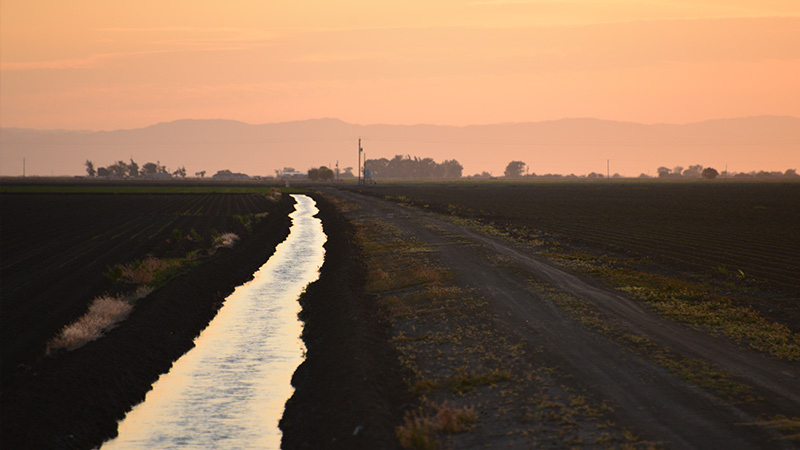Climate Change Increases Crop Water Demand in San Joaquin Valley, Exacerbating Shortage on Groundwater Supplies

Joshua Viers/UC Merced
Image showing a San Joaquin Valley canal carrying irrigation water
UCLA Samueli Newsroom
Climate change has been known to compound California’s drought conditions, but a new study shows it has also affected our water supply in other ways.
Researchers from UC Merced and the UCLA Samueli School of Engineering have found that rising temperatures associated with global climate change are largely responsible for increased farming water demands in the San Joaquin Valley — the southern half of California’s Central Valley and the state’s largest agricultural region.
Published in PLOS Water, the joint study used existing data to estimate water demand for crops from 1980 to 2023 in the San Joaquin Valley. The researchers found a 4.4% increase in the area’s water deficit over the last 10 years compared to the previous three decades. The increase was about 500,000 acre-feet per year from 2012–2023 — enough to fill Millerton Lake, one of California’s large reservoirs.
The researchers, all members of the Secure Water Future project funded by the U.S. Department of Agriculture (USDA), focused on the climate’s effects on crop water demand while accounting for changing land use and management practices. More than half of the increase — what the team describes as an “invisible water surcharge” — was attributed to climate change and the study suggests the situation will continue to worsen amid fluctuations in the state’s water supply.
“Effectively a warmer atmosphere means plants are thirstier, which means crops of all kinds have to work harder and use more water to grow to their ideal harvesting levels,” said study co-author Alvar Escriva-Bou, a UCLA assistant professor of civil and environmental engineering and member of UCLA’s Institute of the Environment and Sustainability.
Crops grown in the San Joaquin Valley are exported around the world. According to the California Department of Food and Agriculture, more than 250 different crops, worth $30 billion per year, are grown in the larger Central Valley. The area accounts for 75% of the irrigated land in California and 17% nationwide. Its farms provide a quarter of the country’s food, including 40% of fruit and nuts, which require a great deal of water to grow.
To compensate for the lack of rain during the growing season in the San Joaquin Valley’s Mediterranean climate, irrigation is provided through a combination of surface and groundwater sources. There is increased reliance on groundwater pumping for agriculture when crop water demands are high and surface water supplies are limited by events such as droughts. Both conditions are often present in the region, which has been subject to an accelerating depletion of groundwater reserves over the past several decades. At the same time, climate variability, including sustained periods of droughts, has put further pressure on aquifers and the water they store.
“Coupled with growing evidence of the declining seasonal Sierra Nevada snowpack, the state’s biggest surface water contributor, this additional stressor on the San Joaquin Valley’s groundwater supplies is very concerning,” said Escriva-Bou, who leads the Escriva-Bou Research Group at UCLA. “Going forward, the study indicates that farmers, water managers and state policymakers also need to take depleted aquifers into account for sustainable crop production.”
The study’s lead author is Kelly Moyers, who was a UC Merced postdoctoral scholar at the time the research was completed. Other authors of the papers are UC Merced professors John Abatzoglou, Josué Medellín-Azuara and Joshua Viers. Viers is also the director of the Secure Water Futures project.
In addition to USDA’s National Institute of Food and Agriculture, other funding organizations for the study are the National Science Foundation and the AI Institute for Transforming Workforce & Decision Support.
An announcement of this study was first published by UC Merced and adapted for this story.
